cyclopaedia.org
Lexicon Technicum 1708
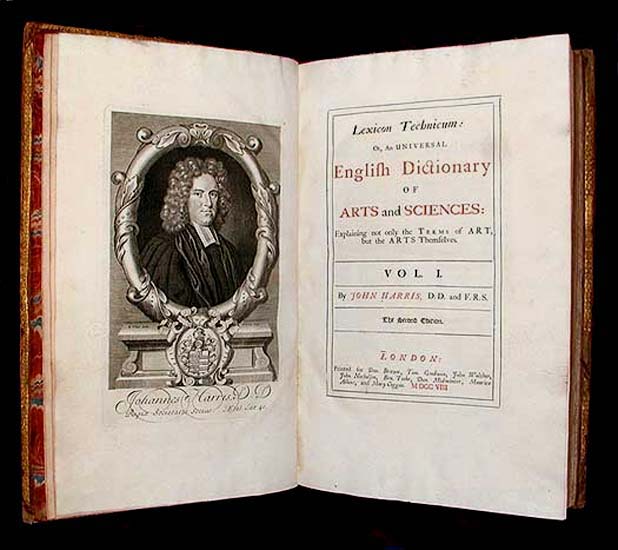
Lexicon Technicum:
or, an Universal English Dictionary of Arts and Sciences:
Explaining not only the Terms of Art, but the Arts Themselves
Harris, John.(1666-1719)
London: Dan. Brown, Tim. Godwin, John Walthoe, & others, 1708 [& 1710]. Folio (40.2 cm, 15.875"). 2 vols. I: Frontis., [449] ff.; 5 plts. (of 7 called for); illus. II: [316] ff. (lacking 2 ff. (Pp. 3‚4)), 44 pp., [5] ff., 120 pp., [31] ff.; 7 plts.; illus.
Second edition of vol. I and first edition of vol. II of the Lexicon technicum: This work is, according to Printing and the Mind of Man, "the first English encyclopaedia arranged in alphabetical order" and also "appears to be the first technical dictionary in any language." It includes articles on law, the church, math, science, and technology, including logarithmic, trigonometric, and astronomical tables. In vol. II, along with other significant pieces by him, is the first appearance in print of Newton's only published work in chemistry, De natura acidorum.
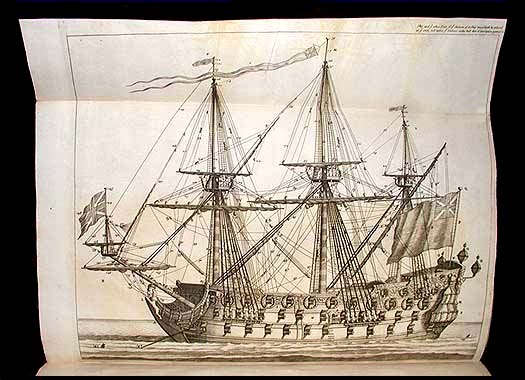
The plates include two detailed views of a ship of the line (the second of which gives an interior view, carefully labelled),
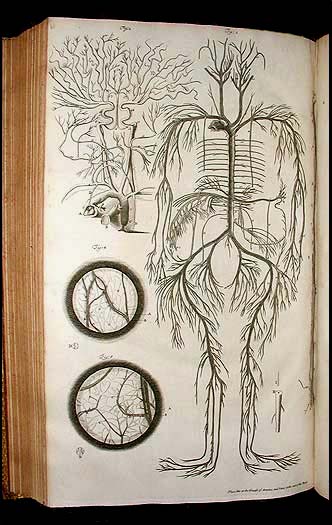
a detailed view of the human circulation system, and a schematic for a barometer.
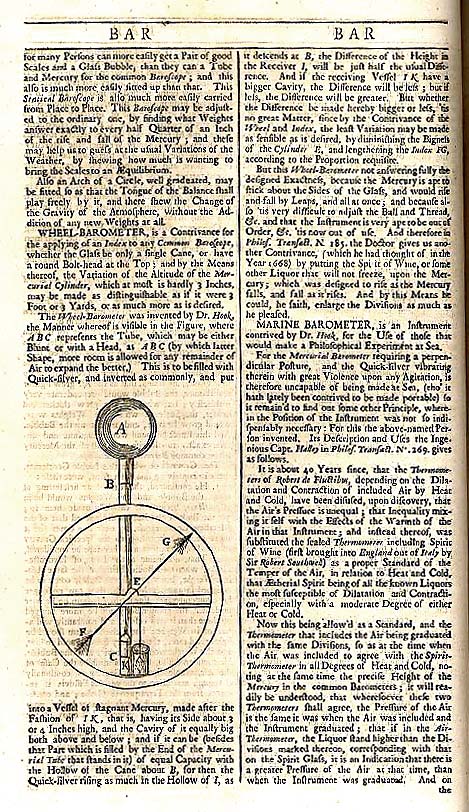
The entries are also illustrated with numerous in-text woodcuts and engravings.
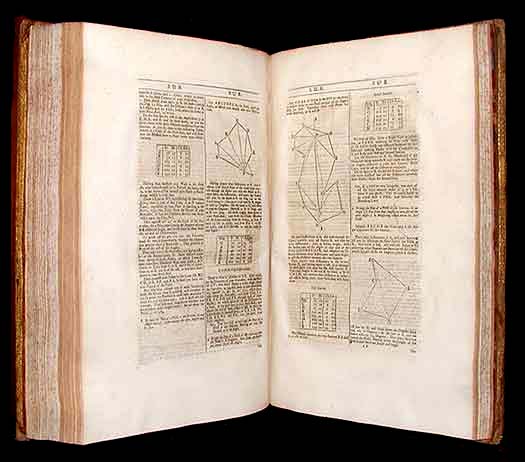
The frontispiece is a fine conventional engraved portrait of Harris, by G. White after R. White. John Harris (1667?‚1719) was a clergyman, mathematician, and topographer, as well as secretary of the Royal Society.
This second edition of vol. I exists in two states, with variant ESTC numbers: This one has a cancel title-page with the name of Mary Coggan substituted for that of Francis Coggan in the list of publishers. Harris issued a three-page proposal for this work in 1702, and the first edition, in one volume, appeared in 1704. This second edition of vol. I appeared 1708 and the first of vol II in 1710, the latter proclaiming in its introduction, "In this second volume . . . the matter is intirely new, and without any repetition . . . of any thing in the former . . . ." The Lexicon technicum apparently proved popular, as it was reprinted a number of times, the last issue appearing in 1744.
"The first important modern scientific encyclopedia. The many articles on technology provide particularly valuable primary material, while the author's access to Newton and others has been frequently emphasised. In physics, astronomy, and mathematics he turned to Newton; in botany he consulted John Ray and Joseph Tournefort; in other areas he drew upon Halley, Robert Boyle, Nehemiah Grew, John Woodward, John Wilkins, William Derham, and John Collins. The important Newtoniana, including first or first English publications of a number of texts may be summarised as follows. In volume I the article 'Moon' is a translation of Newton's 'Theory of the Moon's motion', first published in Latin in Gregory's Astronomiae physicae (1702) and also in English in a rare pamphlet in the same year. The English text printed by Harris is however slightly altered or edited (I.B. Cohen Isaac Newton's theory of the moon's motion, 1975). Volume II contains the first appearance of Newton's only published work on chemistry, 'De natura acidorum'. Newton's chemical theories were held in great esteem for many years 'and a modern historian must agree that Newton's approach to chemical problems [is] very nearly as full of insight, as interesting, and as influential as the eighteenth-century chemists thought them to be' (Marie Boas Hall in I.B. Cohen, ed., Isaac Newton's letters and papers on natural philosophy_, 1958, p. 248). Also in volume II the articles 'Quadrature' and 'Curves,' are the first English translations of Newton's important Latin mathematical papers which were appended to the first editon of Opticks (1704) but dropped from later editions, and there are lengthy excerpts from his works under Attraction, Colour, Comets, Fluxion, Gravity, Light, Heat, Motion, Sun, Telescopes, Tides etc. The article 'Fossils' in vol. I contains Woodward's 'Table of fossils', the first statement of his system of mineral classification. It is not signed but Harris indicates in the preface that he had it from Woodward. It was reproduced, with no important changes in Woodward's Naturalis historia telluris illustrata et aucta (1714), translated into English as The natural history of the earth (1726). Vol. II contains a long article on printing, with woodcuts of composing frame and press; as David McKitterick has recently pointed out this article made the information much more widely available than it had been, Moxon's Mechanick exercises (1683-4) only reaching small readership. The article in the Lexicon is only the second account of printing technology in English, yet for some reason it was overlooked in Bigmore and Wyman's exhautive bibliography of printing. (See David McKitterick, Print, Manuscript and the Search for Order, 1450-1830, Cambridge, 2003, p. 171, and quotations from Harris on 'Reading', p. 205.)"
Ý John Harris (c. 1666 - September 7, 1719), was an English writer. He is best known as the editor of the Lexicon technicum, or Dictionary of the Arts and Sciences (1704), which ranks as the earliest of the long line of English encyclopaedias, and as the compiler of the Collection of Voyages and Travels which passes under his name.
He was born about 1666, probably in Shropshire, and was a scholar of Trinity College, Oxford, from 1684 to 1688. He was presented to the vicarage of Icklesham in Sussex, and subsequently to the rectory of St Thomas, Winchelsea. In 1698 he was entrusted with the delivery of the seventh series of the Boyle Lectures, "Atheistical Objections against the Being of God and His Attributes fairly considered and fully refuted."
Between 1702 and 1704 he delivered at the Marine Coffee House in Birchin Lane the mathematical lectures founded by Sir Charles Cox, and advertised himself as a mathematical tutor at Amen Corner. The friendship of Sir William Cowper, afterwards lord chancellor, secured for him the office of private chaplain, a prebend in Rochester cathedral (1708), and the rectory of the united parishes of St Mildred, Bread Street and St Margaret Moses, in addition to other preferments.
He showed himself an ardent supporter of the government, and engaged in a bitter quarrel with the Rev. Charles Humphreys, who afterwards was chaplain to Dr Sacheverel. Harris was one of the early members of the Royal Society, and for a time acted as vice-president. At his death, he was busy completing an elaborate History of Kent. He is said to have died in poverty brought on by his own bad management of his affairs.
*Printing and the Mind of Man 171; O'Neill, Cordell Collection, H-20 & H-21; Horblit 25a; ESTC T142406 & 142408. On Harris, see: The Dictionary of National Biography, XXV, 13‚14.
l.a.miller@mail.pf





